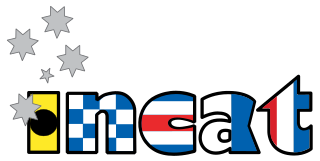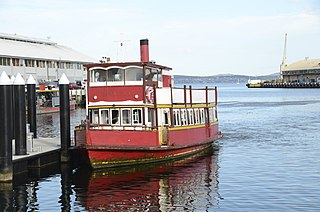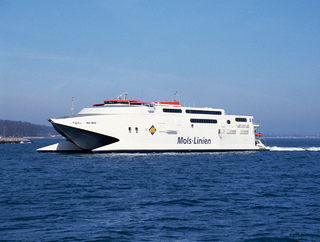
A catamaran is a watercraft with two parallel hulls of equal size. The distance between a catamaran's hulls imparts resistance to rolling and overturning. Catamarans typically have less hull volume, smaller displacement, and shallower draft (draught) than monohulls of comparable length. The two hulls combined also often have a smaller hydrodynamic resistance than comparable monohulls, requiring less propulsive power from either sails or motors. The catamaran's wider stance on the water can reduce both heeling and wave-induced motion, as compared with a monohull, and can give reduced wakes.

A trimaran is a multihull boat that comprises a main hull and two smaller outrigger hulls which are attached to the main hull with lateral beams. Most modern trimarans are sailing yachts designed for recreation or racing; others are ferries or warships. They originated from the traditional double-outrigger hulls of the Austronesian cultures of Maritime Southeast Asia; particularly in the Philippines and Eastern Indonesia, where it remains the dominant hull design of traditional fishing boats. Double-outriggers are derived from the older catamaran and single-outrigger boat designs.

Bay Ferries Limited, or simply, Bay Ferries, is a ferry company operating in eastern Canada and is headquartered in Charlottetown, Prince Edward Island, Canada. It is a subsidiary of Northumberland Ferries Limited and a sister company to the defunct Bay Ferries Great Lakes Limited.

Incat Tasmania is an Australian manufacturer of high-speed craft (HSC) catamaran ferries. Its greatest success has been with large, sea going passenger and vehicle ferries, but it has also built military transports and since 2015 it has built smaller river and bay ferries. Based in Derwent Park, a suburb of Hobart, Tasmania, Australia, it was founded by Bob Clifford.

The Tasman Bridge disaster occurred on the evening of 5 January 1975, in Hobart, the capital city of Australia's island state of Tasmania, when the bulk carrier Lake Illawarra, travelling up the Derwent River, collided with several pylons of the Tasman Bridge and caused a large section of the bridge deck to collapse onto the ship and into the river below. Twelve people were killed, including seven crew on board Lake Illawarra, and the five occupants of four cars which fell 45 metres (150 ft) after driving off the bridge. Hobart was cut off from its eastern suburbs, and the loss of the road connection had a major social impact. The ship's master was officially penalised for inattention and failure to handle his vessel in a seamanlike manner.

HMAS Jervis Bay was a wave piercing catamaran that operated in the Royal Australian Navy (RAN).

HSC Condor Voyager is a high-speed catamaran ferry, owned by Brittany Ferries and chartered to Condor Ferries. Since being built in 2000, the vessel has borne the names Incat Tasmania, The Lynx and Normandie Express. She is designed to travel at speeds of up to 46-and-a-half knots, giving a journey time between Portsmouth and the Normandy ports of three hours per crossing.

HSC Champion Jet 3 is a fast ferry operated by Seajets. Launched in 1997, she was initially chartered out as a civilian ferry, then became the first large catamaran to enter military service when she was commissioned into the Royal Australian Navy as HMAS Jervis Bay from 1999 to 2001.

HSC INCAT 046 was a wave-piercing catamaran passenger-vehicle ferry. It operated under various marketing names, including Devil Cat, The Cat, The Lynx, and lastly The T&T Express.

Ferries in Hobart are a form of public transport in the city of Hobart, Tasmania. Though for decades they had not provided a major alternative public transport service for commuters and tourists in Hobart across the Derwent River, a renewed ferry service began in 2021. This has resulted in a revival of ferry transport in Hobart, including long-term plans to expand the network.

Austal Limited is an Australian-based global ship building company and defence prime contractor that specialises in the design, construction and support of defence and commercial vessels. Austal's product range includes naval vessels, high-speed ferries, and supply or crew transfer vessels for offshore windfarms and oil and gas platforms.

Volcan de Teno is a high speed catamaran operated by Naviera Armas.

HSC Max Mols is a high speed catamaran launched on 1 December 1997 at the Incat shipyard in Tasmania. She has spent the majority of her career serving the Aarhus-Odden route with Mols Linien. She has frequently been chartered to other operators in the Baltic Sea and English Channel. Recently been purchased by Seajets of Greece! It will be delivered to Greece later this year.

Express 1 is a high-speed catamaran operated by Molslinjen between Rønne and Ystad. Along with its sister ship, the Express 2, they are the world's largest diesel-powered catamarans.

The HSC Cat is a high speed catamaran ferry built by Incat for Sea Containers in 1990. It has been owned by Sea and Sun Maritime Co since 2014. The vessel is currently operated by Seajets.
Incat Crowther is an Australian marine engineering company, headquartered in Sydney. Incat Crowther has offices in Lafayette, Louisiana, United States and Eastleigh, England.
Philip Christian Hercus AO BSc was a naval architect and marine vessel designer in Sydney Australia.

The HSC Mega Jet is a high speed catamaran operated by Seajets.
Gladding-Hearn Shipbuilding is a shipyard located in Somerset, Massachusetts on the Taunton River. It primarily builds pilot boats and high-speed catamaran ferries.

MV or HSCSaint John Paul II is a high-speed catamaran ferry owned and operated by Virtu Ferries. Built by Incat in 2017–18, the vessel entered service as a ferry between Malta and Sicily in March 2019. It is the largest vessel of its kind in the Mediterranean Sea, and the second largest in the world.
















